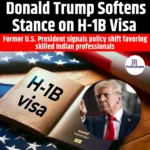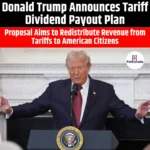Donald Trump Announces Tariff Dividend Payout Plan
|
General Studies Paper II: Effect of Policies & Politics of Countries on India’s Interests |
Why in News?
Recently, US President Donald Trump announced that every American will receive a $2,000 “tariff dividend” as a reward from his trade policies. He emphasized that the payout reflects the success of his economic agenda, portraying it as a benefit for ordinary citizens.
What is the Tariff Dividend Plan?
- About: The Tariff Dividend Plan is a proposed financial initiative under which American citizens would receive at least 2,000 dollars per person as a dividend from the revenue collected through tariffs. This idea was introduced as part of Trump’s broader “economic fairness” message, emphasizing that ordinary Americans should benefit directly from trade measures taken by the government.
- Eligibility: According to the announcement, the tariff dividend would be distributed to all American citizens except those categorized as “high income” individuals. This feature aligns with Trump’s public statements emphasizing fairness and economic reward for working-class Americans who contribute to national productivity. The dividend would also exclude non-citizens and temporary residents.
- Framework: The rules of the Tariff Dividend Plan have not been officially codified, but initial statements suggest a structure based on the total tariff revenue collected by the federal government. The plan may operate through the Internal Revenue Service (IRS), which already handles tax-related payments such as refunds or credits. The president’s team is expected to prepare a framework outlining how the dividend would be calculated and delivered.
- Benefit Distribution: The Tariff Dividend may not necessarily come as a direct check. Instead, it could be offered in multiple forms of tax relief and deductions. These could include no tax on tips, no tax on overtime pay, no tax on Social Security earnings, and possible enhancements to auto-loan deductions. This approach would also help integrate the dividend within the existing fiscal system without requiring new infrastructure.
- Funding Source: The funding for this dividend comes from the tariff revenue collected under Trump’s trade measures, launched earlier in 2025 under what he called “Liberation Day” economic reforms. According to Trump, the U.S. government has earned trillions of dollars in tariff revenue from imported goods since these measures began. The core idea is to convert a portion of these earnings into a people-centered economic dividend.
|
What is Tariff?
|
Trump’s Tariff Policies
- The tariff policies of Donald Trump became one of the defining aspects of his economic strategy during his first presidential term (2017–2021) and 2025. Trump’s approach to trade marked a sharp departure from decades of American free-trade policies.
- During his first term, Trump’s trade policy was formally introduced through the “America First” economic agenda in 2017. His administration imposed tariffs under Section 232 of the Trade Expansion Act of 1962 and Section 301 of the Trade Act of 1974, citing threats to national security and unfair trade practices. In 2018, Trump announced a 25 percent tariff on steel and a 10 percent tariff on aluminum imports.
- After leaving office in 2021, Trump continued to promote his tariff-centered economic philosophy. When he returned to power in 2025, he revived his trade strategy under the International Emergency Economic Powers Act (IEEPA). His new initiative is called “Economic Liberation Day.” The new phase of tariffs aimed at reinforcing national independence from foreign production chains.
- The initiative involved a two-tier tariff structure: a baseline 10% tariff on imports from all non-exempt countries, and additional country-specific tariffs (ranging from 11% to 50%) for countries with which the U.S. had the largest trade deficits. The administration argued that these measures would boost domestic production and create American jobs.
- Economists noted that tariff revenues had crossed $1 trillion in cumulative collections by late 2025, according to official estimates from the U.S. Department of the Treasury.
Why did Donald Trump make the Tariff Dividend Announcement?
- Tariff Legality: The reason behind the announcement was the Supreme Court’s ongoing review of the legality of Trump’s tariff measures in late 2025. The US Supreme Court has declared most of Trump’s tariffs illegal. By announcing a direct citizen benefit linked to tariff collections, Trump sought to demonstrate that these tariffs were not just legal but beneficial. The dividend announcement acted as a political defense, framing the tariffs as a tool for national prosperity rather than executive overreach.
- Counter Inflation: The U.S. economy in 2025 faced ongoing concerns about cost-of-living increases. Prices for housing, fuel, and essential goods remained high compared to pre-pandemic levels. Critics often argued that tariffs contributed to these price pressures by raising the cost of imports. Trump’s announcement of the tariff dividend directly addressed these criticisms by offering a form of relief. By promising that he wanted to turn this into a defensive policy.
- Political Momentum: Donald Trump was focused on rebuilding his political base after facing criticism from opposition leaders, trade partners, and sections of the business community. The tariff dividend provided a powerful narrative tool to re-energize supporters who believed in his populist economic message. It appealed especially to middle-income households and industrial workers in regions.
Challenges Facing Trump’s Tariff Dividend Plan
- National Debt: The United States already carries the highest national debt in the world, estimated at $38.12 trillion as of November 2025, according to Treasury Department data. This debt level equals more than 120 percent of the U.S. Gross Domestic Product (GDP), which stands at around $30 trillion. The government pays over $1 trillion annually in interest on this debt, creating a major fiscal burden. Trump’s dividend proposal could end up increasing debt rather than reducing it, as it would force the government to borrow more to cover the shortfall.
- Higher Prices: While tariffs generate revenue for the government, they also raise the prices of imported goods. When importers pay tariffs, they often pass these costs to buyers. This leads to higher prices for products like steel, electronics, and automobiles. As a result, consumers pay more for everyday goods. The plan offers short-term political appeal, it may not bring lasting economic relief to households already affected by inflationary pressures.
- Uncertain Revenue: Tariff collections depend on the volume of imports entering the country. If tariffs discourage imports, total revenue naturally declines. A slowdown in trade or a drop in consumer demand could sharply reduce future earnings. In addition, other countries may respond by imposing retaliatory tariffs on U.S. exports, which could hurt American businesses and decrease overall trade activity. This dependence on trade flows makes the policy vulnerable.
|
Also Read: America Imposes 25% Tariff on India |










